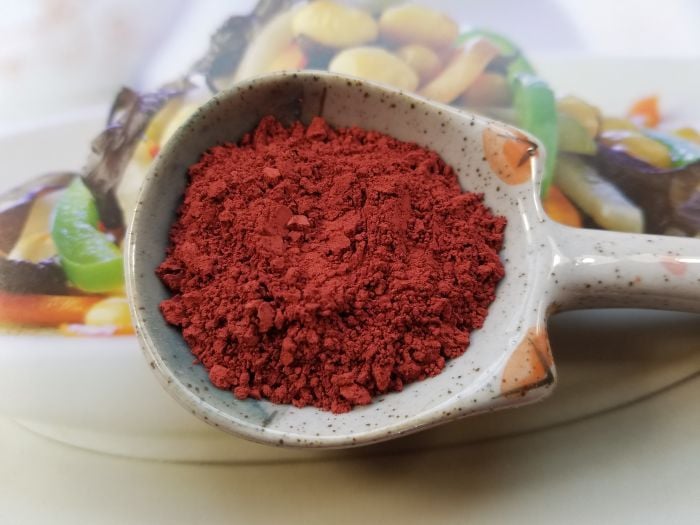
Brian Firth
Sep 5, 2007
I have the Natural Pigments vermilion and want to mull it and tube the paint. I have read about people having problems with tubing hand ground vermilion in the past, with it hardening in the tubes. Are there any special precautions I should take to ensure I don’t waste my valuable pigment? I have aluminum stearate, Natural Pigments, pale grinding oil, aluminum hydroxide, and beeswax. Would you recommend using any of these to stabilize the vermilion in the tube?
George O’Hanlon
Sep 5, 2007
We recommend using aluminum stearate since it not only aids in keeping the pigment in suspension but also helps to wet the pigment. Add 2% to 3% of the total pigment weight of aluminum stearate to the vermilion. Next, add oil to the mixture and macerate with a spatula or palette knife. Add the oil dropwise until you have a very stiff paste, almost the consistency of putty. Let it rest for a few hours, and the paste will soften. Now grind the paste with the muller until the striations or tracks left by pigment particle agglomerations in the paste while grinding are all but gone. You are now ready to tube your paint.
The reason for reports of vermilion hardening in tubes is not due to its drying (vermilion is a slow drier) but rather due to separation. This is inevitable since vermilion is one of the heaviest known—it has a very high specific gravity. Even with aluminum stearate, you will experience some separation with time.
If it does harden in the tube, do not panic. Cut open the end of the tube, remove its contents, grind with a muller, and place in a new tube. You may need to add some oil to the paint if
George O’Hanlon
Sep 5, 2007
You can add bentonite or diatomaceous earth to vermilion as an additional stabilizer. These materials are all but transparent in oil, and even a small amount (say 10% or less of the vermilion pigment weight) can help to prevent pigment separation from oil and also add crispness to the paint consistency.
Brian Firth
Sep 5, 2007
This is exactly the kind of info I was looking for! Thank you very much, George!
Brian Firth
Sep 5, 2007
Lastly, do you recommend using the pale grinders oil with vermilion or just regular refined linseed oil?
George O’Hanlon
Sep 7, 2007
The pale grinders have superior wetting than the refined linseed oil because the acid value of the pale grinders is about 12, whereas the aged, refined is about 2. However, if you use aluminum stearate, this may be moot.
You can make a small test with each oil to see how you like the consistency of the paint. You may not notice much difference with the aluminum stearate.
You may also want to experiment with bodied oils, especially if you like long paint that levels out the brush marks.
This is the advantage of making your own paint because you can vary the consistency of the paint to your liking and achieve special effects.
Kenneth Freed
Sep 7, 2007
Will you give us more information about aluminum stearate as a stabilizer? Specifically, where can you get it, when is it most applicable with paint making, what pigments seem to require it, what alternative substances function like aluminum stearate, and what are the advantages and drawbacks to its use.
Sort of everything you ever wanted to know about stabilizers but were afraid to ask.
George O’Hanlon
Sep 7, 2007
Natural Pigments does not use aluminum stearate in Rublev Oil Colours, although most manufacturers making oil paints today use it or some form of metallic stearate in their formulations. Zinc and aluminum stearates were first used in paint in the early 20th century. Zinc stearate is still used as a matting agent in varnishes, lacquers, and some paints. In contrast, aluminum and magnesium stearates are used in artists’ oil colors as a pigment dispersion and suspension agent.
There are many alternatives to stearates as dispersion and suspension agents in oil colors, such as hydrogenated wax (wax derived from castor oil or castor wax, Ciba Geigy Thixcin is one brand name), floated white clay, bentonite, and diatomaceous earth. Historically, beeswax was added as a stabilizer to oil colors, especially during the 19th century.
An advantage of using stearate in oil paint is its property of stabilizing pigment particles in oil. Aluminum stearate coats the surface of pigment particles and helps prevent settling and reduce the amount of oil needed to wet the pigment. However, for the artist making their own paint, this is not a tremendous advantage, except for the artist who wants to store prepared colors for long periods or to stabilize heavy metal pigments, such as vermilion.
A disadvantage of stearate includes the possible formation of efflorescence on the paint’s surface. This has been noted by conservation scientists and conservators as caused by free fatty acids, which are also found in stearates. Commercial preparations of aluminum stearate contain anywhere from 2 to 7% by weight of free stearic acid (fatty acid). The form of aluminum stearate most appropriate for oil colors (aluminum di- or tri-stearate) contains higher amounts of free stearic acid.
The oil-pigment mixture becomes viscous with aluminum stearate, and the paint can gel with a certain amount of aluminum stearate at lower pigment concentrations. This is used to create a “cheaper” paint since a smaller amount of pigment needs to be used.
Aluminum stearate will soon be available from the Natural Pigments online store (late September 2007), as are the other materials mentioned herein. When buying aluminum stearate from other suppliers, be sure they specify whether or not it is aluminum di- or tri-stearate appropriate for oil-based vehicles, as some forms are not suitable or effective for oil colors.
For more information on this topic, please read:
A Brief History of Aluminum Stearate as a Component of Paint by Charles S. Tumosa, Smithsonian Institution
Clarifying the Haze; Efflorescence on Works of Art by Eugena Ordonez and John Twilley
Kenneth Freed
Sep 7, 2007
Excellent and very complete answer. I have heard of this substance being used in paint for many years, but your answer sheds considerable light on the details. Beautifully done. I want to order some when available. Thanks.











